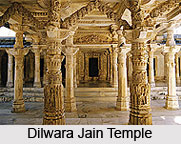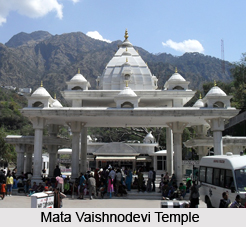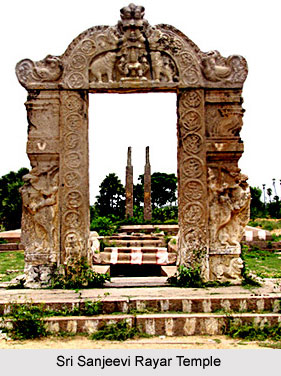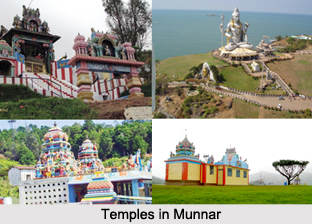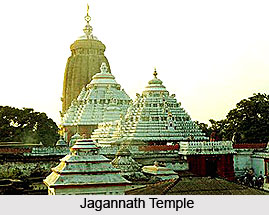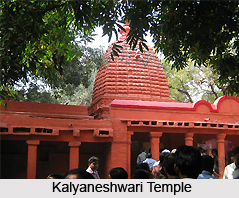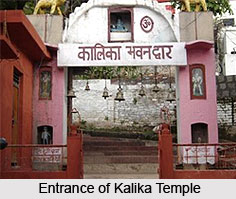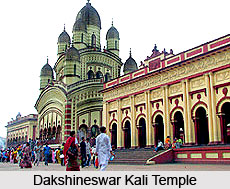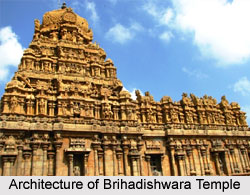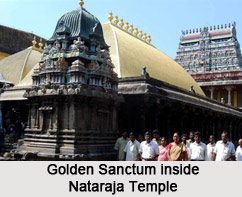 Chidambaram is an ancient and celebrated shrine of India. It is located in the Cuddalore district of Tamil Nadu. The temple has a lot of cultural as well as religious importance in the history of India. In the temple Lord Shiva is worshipped in the form of Nataraj which represents the dance form of the Lord in Ananda Tandava. The Lord is also worshipped in the formless form. According to Hindu literature Chimdambaram is among the five holiest Shiva Temples in India. It represents akasha or aether. It is from the temple of Chidambara that the famous deity of Nataraja had come into popular existence.
Chidambaram is an ancient and celebrated shrine of India. It is located in the Cuddalore district of Tamil Nadu. The temple has a lot of cultural as well as religious importance in the history of India. In the temple Lord Shiva is worshipped in the form of Nataraj which represents the dance form of the Lord in Ananda Tandava. The Lord is also worshipped in the formless form. According to Hindu literature Chimdambaram is among the five holiest Shiva Temples in India. It represents akasha or aether. It is from the temple of Chidambara that the famous deity of Nataraja had come into popular existence.
Antiquity of Chidambaram Natarja Temple
When the temple came about to be is unknown but literature mentions the tradition of Shiva (Nataraja) worship in existence as early as the Sangam period. The later Chola kings (Aditya I and Parantaka I) decorated the roof with gold, and the other Chola kings treated Nataraja as their guardian deity and made several endowments. The Pandya kings followed them, and the Vijayanagar rulers made endowments to the temple. There is a stone image of Krishnadevaraya in the North Gopura, which he erected. During the 18th century the Mysore rulers used this temple as a fort. During this period, the images of Nataraja and Sivakamasundari were housed in the Tiruvarur Tyagaraja temple for safety.
Images are placed at the south gate Each of the four most revered Saivite Saints (Appar, Sundarar, Sambandar and Manikkavacakar) has worshipped at Chidambaram, and their images are placed at the temple entrances corresponding to the points from whence they entered - (Sambandar - South, Appar - West, Sundarar - North and Manikkavacakar - East).
Legends of Chidambara Nataraja Temple
Aadi Sesha, heard about the splendour of Shiva`s cosmic dance and had the desire to witness it. He descended to earth as Patanjali.
Vyagrapaadar, another devotee of Shiva prayed to obtain the tiger`s claws so that he could obtain the sacred Vilva leaves meant for Shiva`s worship at Chidambaram. At the appointed hour, Shiva (with Sivakami) granted to Patanjali and Vyagrapaadar, a glimpse in to his cosmic dance with the other goods accompanied by playing the music. Vishnu witnessed this dance, and the Govindaraja shrine was built to commemorate this. Shiva performed the dance after his victory over the ascetics of Daruka Vanam.
Another legend, states the dance duel between Shiva and Goddess Kali. Lord Shiva lifted his left foot towards the sky in the Urdhuva Tandava posture - a definite male gesture. Kali could not strike a similar pose and so Shiva emerged victorious. Thus Kali was shifted to another temple on the outskirts of Chidambaram. This legend is depicted on the walls of Nritta Sabha, within the Chidambaram temple.
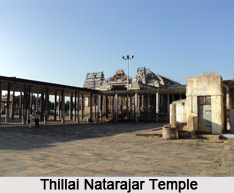 Deity of Chimbara Nataraja Temple
Deity of Chimbara Nataraja Temple
The dance of bliss symbolizes the five divine acts (pancha krityas) of creation, sustenance, dissolution, concealment and bestowment of grace. The dance of Shiva is frozen in time here and is worshipped in Nataraja Sabhas.
Architecture of Chidambara Nataraja Temple
The Architecture of Chidambara Temple is representative of various styles of architecture. It is among the splendid architectures of the country. The several halls and gopurams reflect the magnificence of architecture and artistry. Not only are the architectural features are notice worthy but at the same time the art works and carvings which are present on the pillars and walls of the temple are wonderful.
Worship in Chidambara Nataraja Temple
Six worship services are offered in the temple everyday. The first puja is performed in the morning where the padukas of the Lord are brought back to the main shrine. The worship timmings are as follows 9:30, 12, 5, 7 and at night. The worship carried out night is the most important one. Several Vedic and Tamil hymns are part of the ritual of worshipping the deity. The last or the most important worship is known by the name Ardhajama Puja. In this worship the padukas of Lord Shiva are ceremoniously taken out and are carried to the night chamber of Shiva and Parvati after elaborate rituals. It is believed that during this ritual the entire pantheon of Hindu deities are present in the temple. Unlike many other temples the Chidambaram Nataraja Temple does not follow the Saivite rituals instead follows the rituals set down by Patanjali.
Festivals of Chidambaram Nataraja Temple
Two annual Bhrammotsavams at Chidambaram are of great significance, as they involve colorful processions of festival deities in the car streets. The grandest of these occurs in the month of Margazhi (Dec 15 - Jan 15). The second happens in the month of Aani, and it concludes with Aani Tirumanjanam on the tenth day, in a manner similar to Arudra Darisanam in Margazhi. These festivals precede the summer and winter solstices (ie. Gemini and Sagittarius).












